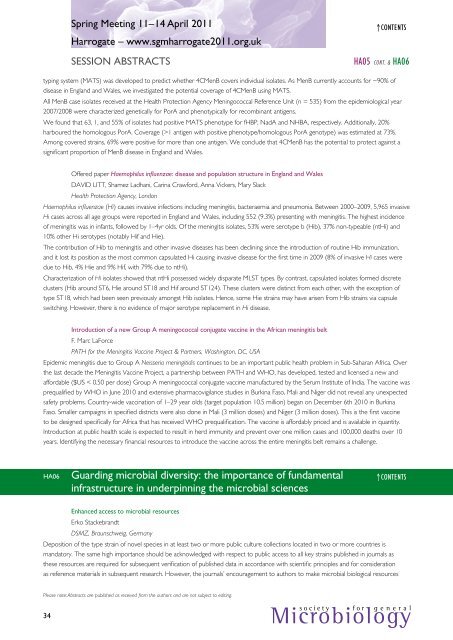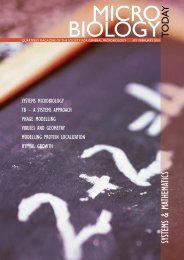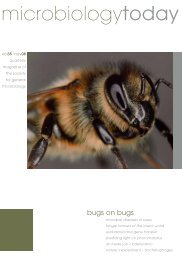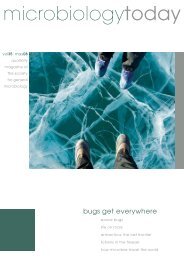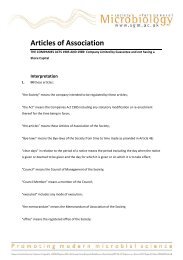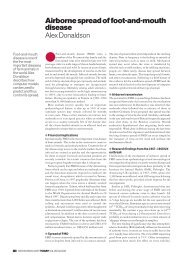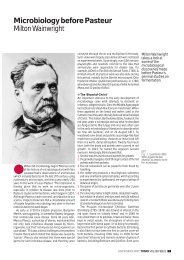Spring Conference 2011 - Society for General Microbiology
Spring Conference 2011 - Society for General Microbiology
Spring Conference 2011 - Society for General Microbiology
You also want an ePaper? Increase the reach of your titles
YUMPU automatically turns print PDFs into web optimized ePapers that Google loves.
Please note: Abstracts are published as received from the authors and are not subject to editing.<br />
34<br />
<strong>Spring</strong> Meeting 11–14 April <strong>2011</strong><br />
Harrogate – www.sgmharrogate<strong>2011</strong>.org.uk<br />
SESSION AbSTrACTS<br />
↑Contents<br />
HA05 Cont. & HA06<br />
typing system (MATS) was developed to predict whether 4CMenB covers individual isolates. As MenB currently accounts <strong>for</strong> ~90% of<br />
disease in England and Wales, we investigated the potential coverage of 4CMenB using MATS.<br />
All MenB case isolates received at the Health Protection Agency Meningococcal reference unit (n = 535) from the epidemiological year<br />
2007/2008 were characterized genetically <strong>for</strong> PorA and phenotypically <strong>for</strong> recombinant antigens.<br />
We found that 63, 1, and 55% of isolates had positive MATS phenotype <strong>for</strong> fHBP, NadA and NHBA, respectively. Additionally, 20%<br />
harboured the homologous PorA. Coverage (>1 antigen with positive phenotype/homologous PorA genotype) was estimated at 73%.<br />
Among covered strains, 69% were positive <strong>for</strong> more than one antigen. We conclude that 4CMenB has the potential to protect against a<br />
significant proportion of MenB disease in England and Wales.<br />
Offered paper Haemophilus influenzae: disease and population structure in England and Wales<br />
DAViD liTT, Shamez ladhani, Carina Craw<strong>for</strong>d, Anna Vickers, Mary Slack<br />
Health Protection Agency, London<br />
Haemophilus influenzae (Hi) causes invasive infections including meningitis, bacteraemia and pneumonia. Between 2000–2009, 5,965 invasive<br />
Hi cases across all age groups were reported in England and Wales, including 552 (9.3%) presenting with meningitis. The highest incidence<br />
of meningitis was in infants, followed by 1–4yr olds. Of the meningitis isolates, 53% were serotype b (Hib), 37% non-typeable (ntHi) and<br />
10% other Hi serotypes (notably Hif and Hie).<br />
The contribution of Hib to meningitis and other invasive diseases has been declining since the introduction of routine Hib immunization,<br />
and it lost its position as the most common capsulated Hi causing invasive disease <strong>for</strong> the first time in 2009 (8% of invasive Hi cases were<br />
due to Hib, 4% Hie and 9% Hif, with 79% due to ntHi).<br />
Characterization of Hi isolates showed that ntHi possessed widely disparate MlST types. By contrast, capsulated isolates <strong>for</strong>med discrete<br />
clusters (Hib around ST6, Hie around ST18 and Hif around ST124). These clusters were distinct from each other, with the exception of<br />
type ST18, which had been seen previously amongst Hib isolates. Hence, some Hie strains may have arisen from Hib strains via capsule<br />
switching. However, there is no evidence of major serotype replacement in Hi disease.<br />
Introduction of a new Group A meningococcal conjugate vaccine in the African meningitis belt<br />
F. Marc laForce<br />
PATH <strong>for</strong> the Meningitis Vaccine Project & Partners, Washington, DC, USA<br />
Epidemic meningitis due to Group A Neisseria meningitidis continues to be an important public health problem in Sub-Saharan Africa. Over<br />
the last decade the Meningitis Vaccine Project, a partnership between PATH and WHO, has developed, tested and licensed a new and<br />
af<strong>for</strong>dable ($uS < 0.50 per dose) Group A meningococcal conjugate vaccine manufactured by the Serum institute of india. The vaccine was<br />
prequalified by WHO in June 2010 and extensive pharmacovigilance studies in Burkina Faso, Mali and Niger did not reveal any unexpected<br />
safety problems. Country-wide vaccination of 1–29 year olds (target population 10.5 million) began on December 6th 2010 in Burkina<br />
Faso. Smaller campaigns in specified districts were also done in Mali (3 million doses) and Niger (3 million doses). This is the first vaccine<br />
to be designed specifically <strong>for</strong> Africa that has received WHO prequalification. The vaccine is af<strong>for</strong>dably priced and is available in quantity.<br />
introduction at public health scale is expected to result in herd immunity and prevent over one million cases and 100,000 deaths over 10<br />
years. identifying the necessary financial resources to introduce the vaccine across the entire meningitis belt remains a challenge.<br />
HA06 Guarding microbial diversity: the importance of fundamental<br />
infrastructure in underpinning the microbial sciences<br />
↑Contents<br />
Enhanced access to microbial resources<br />
Erko Stackebrandt<br />
DSMZ, Braunschweig, Germany<br />
Deposition of the type strain of novel species in at least two or more public culture collections located in two or more countries is<br />
mandatory. The same high importance should be acknowledged with respect to public access to all key strains published in journals as<br />
these resources are required <strong>for</strong> subsequent verification of published data in accordance with scientific principles and <strong>for</strong> consideration<br />
as reference materials in subsequent research. However, the journals’ encouragement to authors to make microbial biological resources<br />
s o c i e t y f o r g e n e r a l<br />
<strong>Microbiology</strong>


